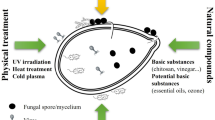Abstract
All the varieties, advanced breeding lines, germplasm lines, and wild species used in the experiments differed significantly for their ability to allow invasion and aflatoxin production by an aflatoxigenicAspergillus flavus strain. Infection and colonisation were strongly correlated (r = 0.82), while there was no relation between infection and aflatoxin content or colonisation and aflatoxin content (r = 0.15). The varieties ICGS11 and S 206 supported less infection and colonisation (range 35 to 40%). Lowest aflatoxin content was recorded in Chitra (3,200 ppb), while it was highest in Kaushal (38,250 ppb). A cross derivative of GAUG1 × NC Ac 17133 R F showed lowest infection and colonisation (86,3 and 25,28%, respectively), and also supported moderate aflatoxin production (4,000 ppb). Among germplasm lines spancross supported lowest aflatoxin production (2,026 ppb) while both the wild species vz. ICG 8127 and ICG 8128 were highly susceptible to infection, colonisation, and aflatoxin production.
Similar content being viewed by others
References
Amaya FJ, Young CT, Mixon AC, and Norden AJ (1977) Soluble amino and carbohydrate compounds in testae of six experimental peanut lines with various degrees ofAspergillus flavus resistance. J Agric Food Chem 25:661–663
Bartz JA, Norden AJ, Laprade JC, Dermuynk TJ (1976) Tolerance to colonisation byAspergillus flavus found in certain peanut breeding lines and cultivars. Proc Amer Peanut Res Educ Assoc 8:94
Benedict CR, Ketring DR, Pettit RE, Dickert JW (1973) Comparison of tolerant and susceptible peanut lines. III. Physiological investigations. J Am Peanut Res Educ Assoc 5:208
Dickens JW (1977) Aflatoxin occurrence and control during growth, harvest and storage of peanuts. In: Rodricks JV, Hesseltine CW, Mehalman MJ (Eds) Mycotoxins in Human and Animal Health, Patholox Publishers, Inc, Illinois, USA. pp 99–105
Ghewande MP, Nagaraj G (1987) Prevention of Aflatoxin contamination through some commercial chemical products and plant extracts in groundnut. Mycotox Res 3:19–24
Ghewande MP, Pandey RN, Shukla AK, Misra DP (1984) Toxicity effects of culture filtrates ofAspergillus flavus on germination of seed and seedling growth of groundnut. Indian Bot Reptr 3:107–111
Ghewande MP, Nagaraj G, Jhala R, Basu MS, Reddy PS (1986) Dry seed resistance toAspergillus flavus colonisation and aflatoxin production in groundnut. Indian J Plant Prot 14:59–64
Mehan VK, McDonald D (1980) Screening for resistance toAspergillus flavus invasion and aflatoxin production in groundnut improvement programme. Occasional paper 2, pp 1–15
Mehan VK, McDonald D (1983) Aflatoxin production in groundnut cultivars resistant and susceptible to seed invasion byAspergillus flavus. In: Proceedings of Int Symp Mycotox, 6–8 September, 1981, Cairo, Egypt, pp 221–226
Mehan VK, McDonald D, Nigam SN, Lalitha B (1981) Groundnut cultivars with resistance to invasion byAspergillus flavus. Oléagineux 36:501
Mixon AC (1976) Development of groundnut lines with resistance to seed colonisation by toxin producing strains ofAspergillus species. PANS 25:394–400
Mixon AC (1981) Reducing aflatoxin contamination in peanut genotypes by selection and breeding. J Amer Oilchemists’ Soc 58:961A–966A
Mixon AC, Roger KM (1973) Peanut accessions resistant to seed infection byAspergillus flavus. Agron J 65:560–562
Nagarajan V, Bhat RV, Tulpule PG (1978) Some recent studies in aflatoxin. Proc Nutrition Soc India 16:52–56
Priyadarshini F, Tulpule PG (1978) Relationship between fungal growth and aflatoxin production in varieties of maize and groundnut. J Agric Food Chem 26:249–252
Rao SK, Tulpule PG (1967) Varietal differences of groundnut in the production of aflatoxin. Nature 214:738–739
Zambettakis C, Bockelee-Morvan A (1976) Research on the structure of the seed tegument of groundnut and its effect on penetration ofAspergillus flavus. Abstr Rev Plant Pathol 55:5433 (1976)
Zambettakis C, Waliyar F, Bockelee-Morvan A, De Pins Q (1981) Results of four years of research on the resistance of groundnut varieties toAspergillus flavus. Oleagineux 36:377–385
Author information
Authors and Affiliations
Rights and permissions
About this article
Cite this article
Desai, S., Ghewande, M.P., Nagaraj, G. et al. Screening for resistance to Aspergillus flavus and aflatoxin production in groundnut. Mycotox Res 7, 79–84 (1991). https://doi.org/10.1007/BF03192170
Received:
Accepted:
Issue Date:
DOI: https://doi.org/10.1007/BF03192170




